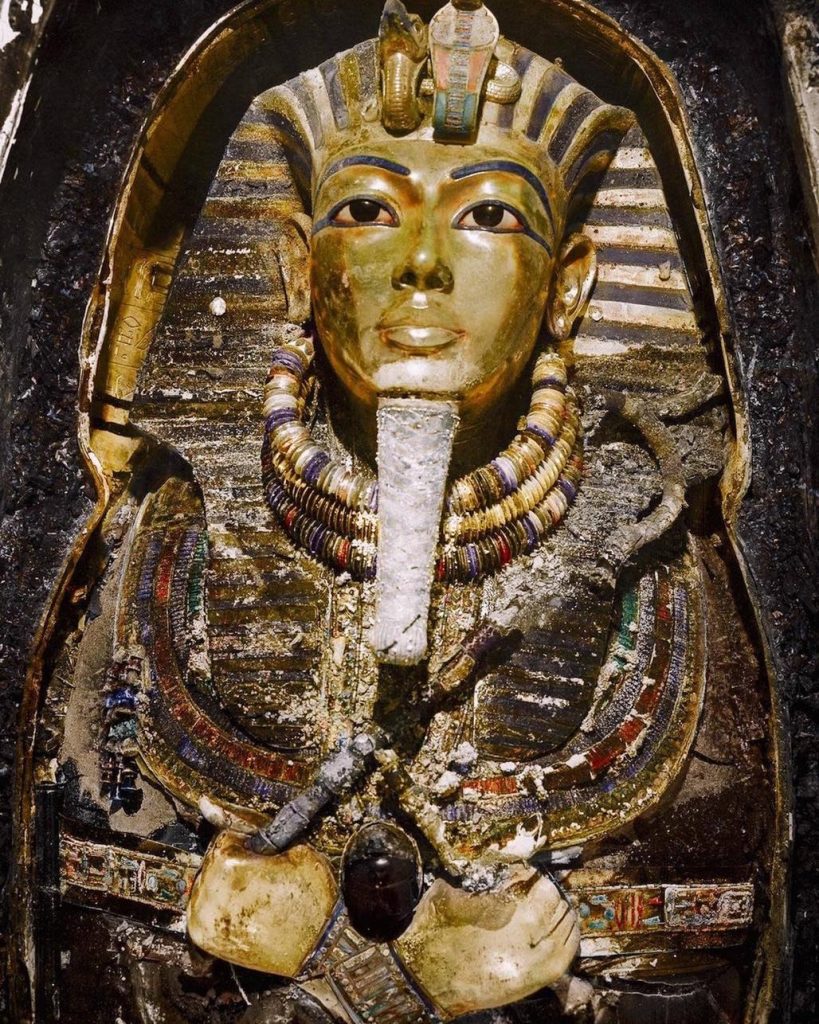To commemorate the 100th anniversary of the discovery of Tutankhamun’s tomb, Garry Shaw, author of a new biography on the Egyptian Boy King, delves into lesser-known details about the world’s most iconic death mask. Since its unearthing in the Valley of the Kings in 1922, Tutankhamun’s golden death mask has emerged as a universal symbol of ancient Egypt. Widely regarded as a masterpiece of ancient craftsmanship, it has been admired by millions of people, either at its home in Cairo or through international exhibitions. Despite being meticulously examined, researchers continue to uncover new insights into its creation and history. Here are four surprising facts about this extraordinary artifact.

Gold and Lapis Lazuli from Distant Lands
The gold used in Tutankhamun’s mask was sourced over 3,300 years ago from Egypt’s eastern desert or Nubia, a region south of Egypt abundant in natural resources and integrated into the pharaohs’ expansive empire. Workers braved the searing desert heat, grinding quartzite rocks to extract minute gold particles and panning the sands for additional yields. Once collected, the gold was smelted into ingots and sent to palace craftsmen, who shaped it into intricate forms.
The lapis lazuli used for the mask’s eyebrows and the cosmetic detailing around the eyes came from the mountains of Badakhshan in Afghanistan, thousands of miles away. Ancient miners employed a fascinating technique to extract this precious stone: they built fires against the rock face and then doused the heated stone with water, causing it to crack and reveal the lapis lazuli. These rough stones entered the Near Eastern trade network, passing through Mesopotamia and eventually reaching Egypt, often as royal gifts from Babylonian kings. Additional precious stones for the mask were sourced from the deserts flanking the Nile Valley, while the obsidian used for the pupils likely came from Ethiopia.
Was the Mask Made for Someone Else?
Recent research led by Egyptologist Nicholas Reeves suggests that the face of the mask, which portrays an idealized version of Tutankhamun, may have been a later addition to a pre-existing design. This raises the intriguing possibility that the mask was originally crafted for another individual, most likely King Neferneferuaten. Neferneferuaten is believed to have been Tutankhamun’s predecessor and may have been Queen Nefertiti ruling as a king. Evidence suggests that several funerary items originally intended for Neferneferuaten were repurposed for Tutankhamun, implying she was never interred with them. Supporting this theory, one of the cartouches—the oval shapes containing a pharaoh’s name—was altered from Neferneferuaten’s name to Tutankhamun’s.
Clumsy Mishaps in Ancient Times
Despite the reverence shown by Egyptian embalmers and priests when handling royal mummies, accidents occurred during funerary ceremonies. One corner of the headdress on Tutankhamun’s mask shows evidence of ancient damage. Nicholas Reeves posits that the mummy might have toppled over during a ritual, possibly when priests positioned it upright for specific rites. Supporting this theory, Howard Carter, the British archaeologist who discovered Tutankhamun’s tomb, found fragments of gold straps, originally used to secure the mummy, scattered in the burial chamber and its corridor. Additionally, the vulture emblem on the mask’s headdress has mysteriously lost its eyes, hinting at another mishap. These irregularities provide compelling clues about the challenges faced during ancient funerals.
Extreme Measures to Free the Mask
During Tutankhamun’s funeral, priests poured copious amounts of resin over the mummy. Once solidified, this resin bonded the body, the gold mask, and the coffin into a single, immovable mass. When Carter’s team attempted to separate them, they faced significant difficulties. Ultimately, they resorted to drastic measures. To retrieve the mummy’s remains, Carter and his assistants dismembered the body, carefully removing its parts and reassembling them on a tray. However, the mask—still attached to the severed head—remained stuck. To detach it, they used heated knives to melt the resin encasing the head. Later, Carter suspended the coffin upside down over paraffin lamps, allowing the heat to loosen the resin holding the mask. While this method successfully freed the mask, it caused several inlays to loosen and fall out. Carter spent days painstakingly restoring them to their original positions.
Tutankhamun’s golden mask remains one of the most celebrated artifacts of ancient Egypt, symbolizing the opulence, artistry, and mystique of a bygone civilization. Despite its fame and extensive study, it continues to yield new insights, offering a deeper understanding of the craftsmanship and cultural practices of the ancient world. Garry Shaw’s latest book, The Story of Tutankhamun: An Intimate Life of the Boy Who Became King, delves further into the life and legacy of this enigmatic pharaoh, shedding light on his enduring impact on history and art.





